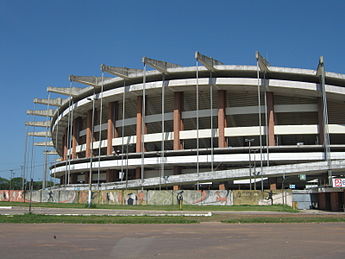Mangueirão
Mangueirão | |
 Estádio Olímpico do Pará exterior | |
 | |
| Full name | Estádio Estadual Jornalista Edgar Augusto Proença |
|---|---|
| Former names | Estádio Olímpico do Pará Alacid Nunes |
| Location | Belém, Pará, Brazil |
| Coordinates | 1°22′52.0″S 48°26′38.4″W / 1.381111°S 48.444000°WCoordinates: 1°22′52.0″S 48°26′38.4″W / 1.381111°S 48.444000°W |
| Owner | Pará State Government |
| Capacity | 53,645 (after reinauguration) |
| Record attendance | 65,000 (Remo vs. Paysandu, 11 July 1999) |
| Field size | 105 x 68 m |
| Surface | Grass |
| Construction | |
| Broke ground | 1971 |
| Built | 1971–1978 |
| Opened | 4 March 1978 |
| Renovated | 2002, 2021–2022 (in progress) |
| Expanded | 2002, 2021–2022 (in progress) |
| Closed | 2021 |
| Architect | Alcyr Meira |
| Tenants | |
| Paysandu Remo Tuna Luso | |
The Estádio Olímpico do Pará, also known as Mangueirão and Estádio Estadual Jornalista Edgar Augusto Proença (State Stadium Edgar Augusto Proença, in English) is a football stadium inaugurated on March 4, 1978 in Belém, Pará, with a maximum capacity of 45,007 spectators.[1]
The stadium is owned by the Pará State Government, and is the home ground of Paysandu Sport Club, Clube do Remo and Sport Club Belém. Its formal name honors Edgar Proença, a journalist and sport announcer of Pará state, and the founder of , the first Pará radio station.
History[]

The Mangueirão stadium architectonical project is from August 1969. The Stadium was designed by Alcyr Meira, a local architect.[2] The Pará State Governor of that time, Alacid Nunes ordered a 120,000 people football stadium construction project. The works started in 1970, when were built the ditch, the field and the general bleachers. A year later, the project was changed, and the stadium maximum capacity was reduced from 120,000 to 70,000. In 1971 the construction works restarted, with the construction of the first structural module.
In 2002, 24 years after the stadium inauguration, Mangueirão was reinaugurated as an olympic stadium. R$30 million were spent by the government of Pará state.
Mangueirão's most important match was the first leg of Copa dos Campeões final, played on July 31, 2002, when Cruzeiro beat Paysandu 2-1.
The inaugural match was played on March 4, 1978, when a Pará State all-stars team beat a Youngsters Uruguay national team 4-0. The first goal of the stadium was scored by Pará's Mesquita.
The reinaugural match was played on May 1, 2002, when Remo and Paysandu drew 2-2. The first goal of the stadium after the reinauguration was scored by Remo's Balão.
The stadium's attendance record currently stands at 65,000, set on July 11, 1999 Remo vs. Paysandu match.
The stadium's attendance record after the reinauguration currently stands at 57,248, when Boca Juniors beat Paysandu 4-2.
Brazil national football team[]
| Date | Time (UTC–3) | Team #1 | Res. | Team #2 | Round | Attendance |
|---|---|---|---|---|---|---|
| 8 November 1990 | Undisclosed | 0–0 | Friendly | 33,664 | ||
| 9 October 1997 | Undisclosed | 2–0 | Friendly | Undisclosed | ||
| 12 October 2005 | 21:30 | 3–0 | 2006 FIFA World Cup qualification | 47,000 | ||
| 28 September 2011 | 21:50 | 2–0 | 2011 Superclásico de las Américas | 45,000 |
See also[]
- Grande Premio Brasil Caixa de Atletismo
References[]
- ^ "CNEF - Cadastro Nacional de Estádios de Futebol" (PDF) (in Portuguese). Confederação Brasileira de Futebol. Archived from the original (PDF) on May 10, 2013. Retrieved March 3, 2011.
- ^ UFPA
- Enciclopédia do Futebol Brasileiro, Volume 2 - Lance, Rio de Janeiro: Aretê Editorial S/A, 2001.
- (in Portuguese) Templos do Futebol
External links[]
| Wikimedia Commons has media related to Estádio Olímpico do Pará. |
- Football venues in Pará
- Belém
- Paysandu Sport Club
- Clube do Remo
- Tuna Luso Brasileira
